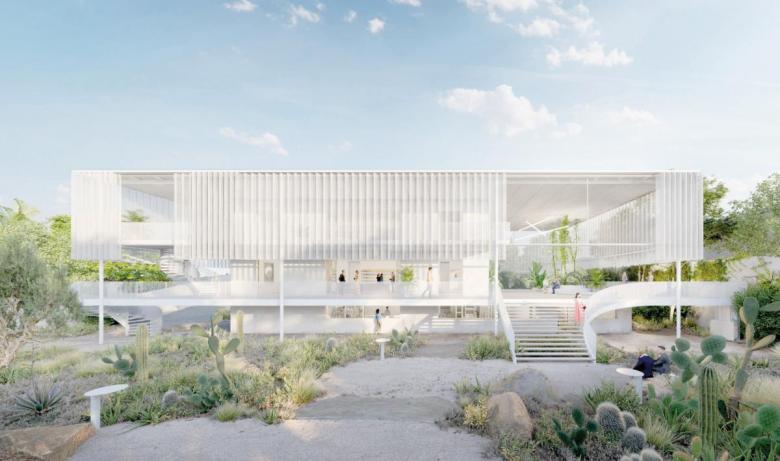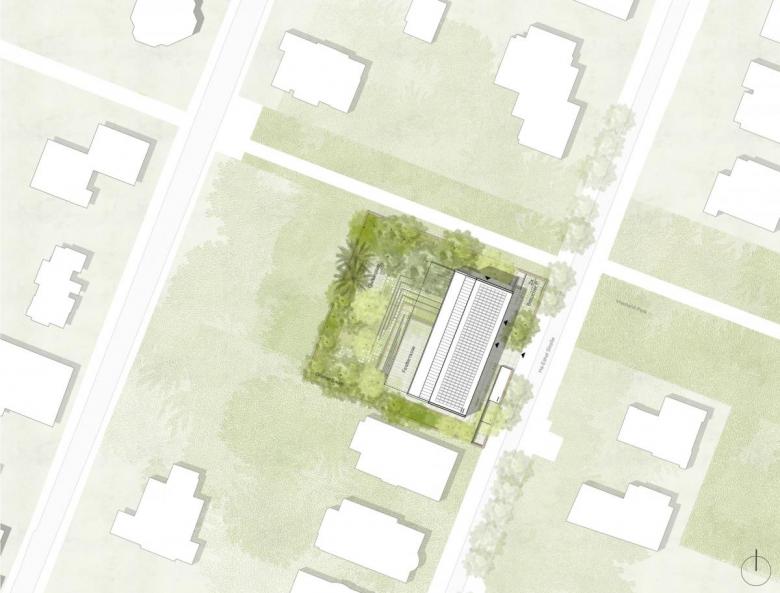25. August 2023
1st Prize: Gustav Düsing, wolff:architekten and Architekten für nachhaltiges Bauen with emmerik garden design and research
In the competition for the Residence of the German Embassy in Herzliya, Israel, the jury selected a joint design submitted by the three architectural firms: Gustav Düsing, wolff:architekten, and Architekten für nachhaltiges Bauen, with landscape design by emmerik garden design and research.
The year 2045 (initially it was to be 2050) is, according to the German government, when the building stock should be designed and redesigned to be — nearly, it says — climate-neutral. The "EnEff.Gebäude.2050" funding initiative promotes model innovation projects that can increase energy efficiency and the share of renewable energies. The ambitious "Energiewendebauen" project of the German Federal Ministry of Economics and Climate Protection also influences the German government's building projects abroad, and so the Federal Office for Building and Regional Planning's (Bundesamts für Bauwesen und Raumordnung / BBR) competition for the Residence of the German Embassy in Herzliya, Israel, north of Tel Aviv, also included the desire for a building based on the low-tech principle that “favors robust, low-maintenance, structural solutions over technical solutions.” Thus, the participating teams were required to ensure this approach as part of the competition process, “taking into account the local climatic parameters.”
Model of 1st Prize (Photo: Ulrike Ludwig and Winfried Mateyka, Berlin)
Site Plan of 1st Prize (Drawing: Gustav Düsing, wolff:architekten and Architekten für nachhaltiges Bauen with emmerik garden design and research)
According to the jury, chaired by Markus Allmann of allmannwappner, this was best achieved by the team headed around Gustav Düsig. They redesigned the existing, outdated embassy building and the surrounding garden in such a way as to create a variety of spatial possibilities while at the same time preserving the character of the residence. In their design, the team refers to the principle of “eco-minimalism,” in which reduction and conservation of resources are design-determining factors.
But how does this work in a subtropical zone on the Mediterranean, where hot, dry summers alternate with winters with high precipitation? With a new building envelope, the design generously overlaps the existing building, creating an intermediate climatic zone between the two layers and leaving room for new and complementary uses. The curtain metal facade is supposed to be movable and adaptable — how feasible this will be was discussed in the jury, which described the overall design as a work that “embodies the German residence in Israel with soothing modesty, continuing the tradition of diplomatic representation there.” The sustainable construction of the redesign convinced the jury, as did the proposed dry garden, which will allow for vegetation appropriate to the time and place, and without intensive irrigation.
2nd Prize: Gerber Architekten GmbH, Dortmund
Model of 2nd Prize (Photo: Ulrike Ludwig and Winfried Mateyka, Berlin)
Site Plan of 2nd Prize (Drawing: Gerber Architekten GmbH, Dortmund)
The design by the firm that placed second, Gerber Architekten, opens up the ground plan to the garden in a comb-like manner through five cubic volumes. Visually, this creates the impression of individual houses standing close together, the proportions of which seemed “somewhat arbitrary” to the jury. The most interesting aspect of the design is that the entrance situation allows visual connections to the lower, elevated main reception area and garden.
The third-place entry came from the team of Sacker Architekten and freisign Landschaftsarchitektur, both from Freiburg. According to the jury, the European character of the load-bearing structure in wood and loam is interesting, but it brings with it too pronounced a grid pattern that weakens the overall impression of the building as a prestigious embassy residence. It also notes that a wooden building in Israel would require special protective measures and intensive maintenance, which is not in line with the basic idea of the tender.
3rd Prize: Sacker Architekten GmbH, Freiburg, and freisign Landschaftsarchitektur Part GmbH, Freiburg
Model of 3rd Prize (Photo: Ulrike Ludwig and Winfried Mateyka, Berlin)
Site Plan of 3rd Prize (Drawing: Sacker Architekten GmbH, Freiburg, and freisign Landschaftsarchitektur Part GmbH, Freiburg)
In addition to the three prizes, two recognitions have been given: One to the team Bundschuh Architekten and 100 Landschaftsarchitektur, both from Berlin, and one to LKK Lehrecke Kammerer Keiss Architekten and Beusch Landschaftsarchitekten BDLA.
THE COMPETITION JURY:
- Prof. Markus Allmann (Chair), allmannwappner gmbh, München
- Marianne Mommsen, relais Landschaftsarchitekten, Berlin
- Matthias Rammig, Transsolar, Stuttgart
- Nazmi Shehadeh, Nazmi Shehadeh Architekten, Nazareth
- Ramona Schwertfeger, LagerSchwertfeger GmbH, Berlin
- Botschafter Steffen Seibert, Federal Foreign Office (AA)
- Christine Eichelmann, Ref. 111-4, Federal Foreign Office (AA)
- Dirk Scheinemann, Head of Department B, Federal Ministry for Housing, Urban Development and Building (BMWSB)
- Petra Wesseler, President of Federal Office for Building and Regional Planning (BBR)
- Kathrin Heimann, Cost Expert, Kemmermann Projektmanagement
- Steven Damiano, Sustainability Expert, Ref. IIIA4, BBR
Related articles
-
Pleasantly Modest
on 8/25/23








